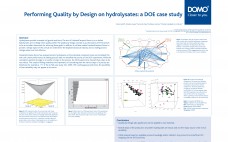Continuous Perfusion is comparatively unpopular rather than considered as a first choice production platform for complex biopharmaceutical glycoproteins. Major concerns that have been addressed are mainly related to risk of process failure during long-term operation, complexity and scalability of cell retention devices, supply and definition of consecutive lots and, finally, handling of continuous harvests in downstream processing. We have cleared-up these stereotypes and designed a robust modular perfusion-based production platform for biopharmaceuticals demanding highest quality at industrial scale. Main components…
Monday, November 7, 2011 Daily Archives
When downstream process is able to withstand upstream changes! An example of clarification sequence optimization in viral vaccine production
While improving cell growth and viral productivity in USP, DSP may become the production bottleneck if not able to withstand changes. Such a case appears when optimizing cell culture media during the development of a viral vaccine candidate. Thirty percent expression increased was balanced by twenty percent yield loss and filters clogging during the clarification step. As a consequence, clarification sequence was not scalable anymore for the further manufacturing. The poster describes sanofi pasteur approach to overcome this issue and…
Characterization of a Novel High-Capacity Weak Cation Exchange Resin
Ion exchange resins with increased selectivity and binding capacity are now in demand and it is imperative for chromatographers to have such resins in their repertoire. The Toyopearl GigaCap® family of resins was created to meet these demands. This poster will focus on Toyopearl GigaCap CM-650M resin as a novel high-capacity weak cation exchange resin for the purification of biomolecules. A polymethacrylic base bead, Toyopearl HW-65, was chemically modified with carboxymethyl groups in the 1000Ã… pores of the bead which…
Towards the Use of Statistical Modeling to Predict Cell Culture Performance of Hydrolysates
Hydrolysates are complex media supplements composed of many as well as different types of components. Predicting cell culture performance of a particular lot remains an elusive target, other than by small scale cell culture testing which consumes valuable time, effort and resources. In order to reduce the need for incoming acceptance tests by our customers, FrieslandCampina Domo plans to develop a simple analytical assay that accurately predicts cell culture performance. Our Quality by Design project has provided information at the…
Performing Quality by Design on hydrolysates: a DOE case study
Hydrolysates provide increased cell growth and titers. The aim of FrieslandCampina Domo is to re-define hydrolysates and re-design their quality profile. The Quality by Design concept as put forward by the FDA proves to be an excellent framework for achieving these goals. In addition it will also enable FrieslandCampina Domo to provide a Design Space of this critical raw material for the biopharmaceutical industry and so making process changes easier and cost effective. FrieslandCampina Domo has analysed protein hydrolysates at…
Evaluation of Ultra Performance Size Exclusion Chromatography for the Analysis of Proteins and Higher Order Aggregates
Complete characterization and analysis of biopharmaceuticals includes size exclusion chromatography (SEC) to measure protein aggregates and other size variants. Current silica-based HPLC-SEC methods can be time-consuming and unreliable. New advances in packing materials and instrumentation have allowed faster and more reproducible separations to be achieved. Improvements in resolution, sensitivity and throughput will be demonstrated for sub-2 μm SEC packing materials as compared to traditional silica-based columns. The effect of pore size and particle size for the analysis of aggregates and…






